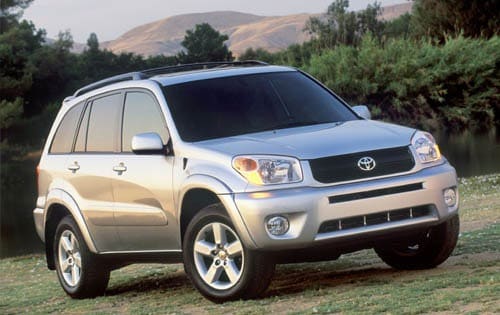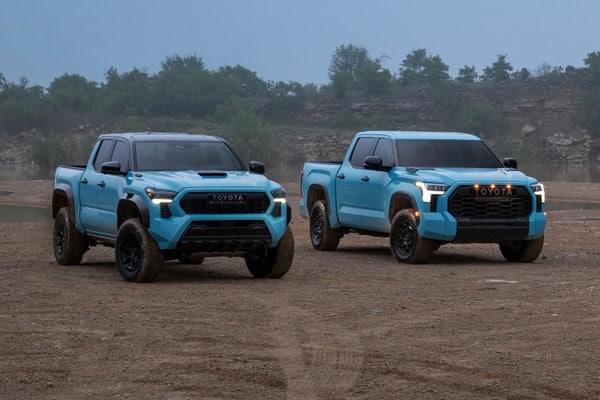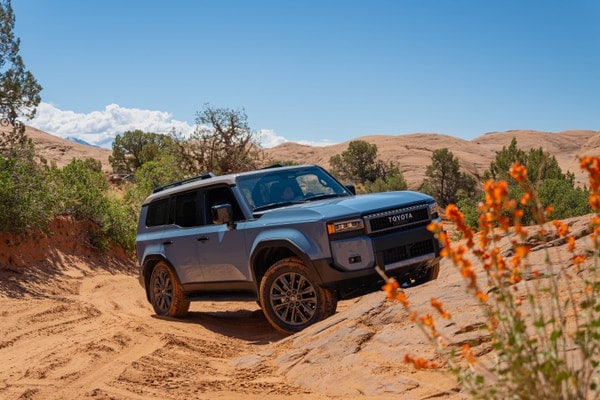2005 Toyota RAV4 Review
Price Estimate: $1,397 - $2,347
 View 51 more photos
View 51 more photos View 51 more photos
View 51 more photos View 51 more photos
View 51 more photos View 51 more photos
View 51 more photos View 51 more photos
View 51 more photos+47
Edmunds' Expert Review
by the Edmunds Experts
Pros
- Steers and handles like a car, thoughtful cabin design, exemplary build and materials quality, ABS and stability control standard, refined and fuel-efficient engine.
Cons
- Somewhat cramped interior, high repair costs in low-speed rear collisions, not much off-road ability.
What’s new
The JBL 3-in-1 audio system has been discontinued, and the sport package receives a unique metal mesh grille and silver sport pedals.
Edmunds says
With ample power under the hood, nimble handling on the street and a generous standard features list, the 2005 Toyota RAV4 is a worthy adversary for mini-utes like the Honda CR-V and Ford Escape.
For sale near Mountain View, CA
62 listings
- 159,993 miles
- No accidents, 3 owners, personal use only
- 5 Seats, 19 City / 25 Hwy MPG, Manual
- Mercy Auto Center (90 mi away)
- AWD/4WD
- Tire Pressure Warnin...
- Rear Bench Seats
- Stability Control
- Fold Flat Rear Seats
Close
Located in Sacramento, CA
2005 .... TOYOTA ...... RAV4 ......... Base AWD 5 SPEED MANUAL 4dr SUV...SUPER CLEAN INTERIOR AND EXTERIOR................POWER WINDOW.....POWER DOOR...
AutoCheck Vehicle History Summary
Accident Free Vehicle: Yes
Personal Use Only: Yes
History Provider: AutoCheck
Title Details: Clean Title
Salvage Vehicle: No
Frame Damage: No
Theft History: No
Lemon Status: No
Free History Report: No
Features and Specs:
21 Combined MPG (19 City/25 Highway)
Listing Information:
VIN: JTEHD20V450060266
Stock: 060266
Certified Pre-Owned: No
Listed since: 06-26-2024- 118,639 miles
- 1 accident, 2 owners, personal use only
- 5 Seats, 21 City / 27 Hwy MPG
- AutoNation Ford Torrance (326 mi away)
- Tire Pressure Warnin...
- Rear Bench Seats
- Stability Control
- Fold Flat Rear Seats
- Audio and cruise con...
Close
Located in Torrance, CA
Roof RackCarpeted Floor Mats/Cargo Mat Set50-State EmissionsThis vehicle includes a Money-Back Guarantee* and passed our precise inspection proce...
AutoCheck Vehicle History Summary
Accident Free Vehicle: No
Personal Use Only: Yes
History Provider: AutoCheck
Title Details: Clean Title
Salvage Vehicle: No
Frame Damage: No
Theft History: No
Lemon Status: No
Free History Report: No
Features and Specs:
23 Combined MPG (21 City/27 Highway)
Listing Information:
VIN: JTEGD20V550092879
Stock: 50092879
Certified Pre-Owned: No
Listed since: 07-03-2025
Vehicle overview
In the mid-1990s, the Toyota brain trust took a close look at the SUV market and determined that not everybody liked the idea of piloting a three-ton land yacht in order to take advantage of the "U" in SUV. File drawers full of focus group questionnaires pointed toward a vehicle that combined the advantages of a sport-utility -- great visibility, sizable cargo capacity, all-weather capability -- with the manageable size and drivability of a car. With that in mind, Toyota's designers looked past their bulky truck frames and gas-guzzling engines and came up with a car-based SUV that merged trucklike utility with carlike maneuverability.
Introduced in 1996, the RAV4 (Recreational Active Vehicle -- four-wheel drive) combined sporty good looks, a convenient size and an economical engine into an attractive and affordable package. It was an instant hit, and as the first example of a car-based sport-utility, the RAV4 enjoyed phenomenal sales that brought with them an onslaught of new competitors hoping to cash in on the newfound niche. Vehicles like the Honda CR-V and Suzuki Grand Vitara soon hit the market sporting bigger engines and more refined interiors, promptly shuffling the aging RAV4 toward the bottom of the category it had single-handedly created. Despite a dose of additional power in 1999, the RAV was getting left behind, and with more competition on the way, Toyota knew a complete redesign was in order to keep its ground-breaking sport-utility at the top of its game.
This led to the current-generation RAV4, introduced for 2001. It has a refined look thanks to sharply upswept headlights and crisp lines that stretch the length of the vehicle. Squint hard enough and Toyota's latest mini-ute could even pass for a poor man's BMW X5, sans the neck-snapping V8 of course. Unlike some other SUVs, the RAV4 can't be ordered with a V6. Until last year, the mini-ute's weak, buzzy 2.0-liter, four-cylinder engine was a notable disadvantage next the Honda CR-V's larger, more potent 2.4-liter four-cylinder and the Ford Escape's 200-horsepower V6. Toyota responded by installing a larger 2.4-liter engine under the hood that produces 161 hp and 165 pound-feet of torque.
Our other main complaint about the RAV4 was its short standard features list that forced buyers to pay extra for basics like air conditioning, cruise and power windows and locks. Now you'll find all of these on the standard equipment list, along with ABS and stability control. Meanwhile, front side-impact airbags and full-length head curtain airbags are on the options list. With these upgrades and freshened styling that's slightly less toylike, this fun-to-drive mini-ute makes great sense as a durable urban runabout and commuter vehicle -- which is just what most people need most of the time.
Performance & mpg
Both 2WD and AWD versions of the RAV4 are powered by a 2.4-liter, four-cylinder engine that delivers 161 horsepower and 165 pound-feet of torque. Buyers can choose either a five-speed manual transmission or a four-speed automatic. Fuel economy is excellent, and buyers can expect to get 22 to 25 mpg in the city and 27 to 31 mpg on the highway.
Safety
Four-wheel antilock disc brakes are standard, as is Toyota's VSC stability control system. Side airbags for front occupants and full-length side curtain airbags are optional. The RAV4 fared well in government crash tests, earning four out of five stars for frontal impact protection and a perfect five stars for side impacts. It also earned a "Good" rating (the highest) in frontal offset and side-impact crash testing by the IIHS (the RAV4 is the first vehicle to earn a "Best Pick" designation for both frontal and side-impact tests). One other item of note is the RAV4's lack of a rear bumper. Low-speed crashes that damage the rear of the vehicle can lead to high repair costs.
Driving
Intended for a life on pavement, the RAV4 really shines in this environment, where its taut suspension, quick steering and tight turning radius come together to produce one of the best-handling SUVs we've ever driven. Minimal body lean and sticky street tires combined with the traction of all-wheel drive provide reassuring handling in almost all situations. With a capable and refined 2.4-liter engine installed under the hood, the RAV4 has the power to complement its sharp reflexes.
Interior
Inside, buyers will find a set of stylish white-faced gauges. As usual, all controls are simple and straightforward to use. Thoughtful design elements include adjustable cupholders and well-placed storage bins. There's plenty of room for four passengers, but throw in a fifth and things get a little tight. Behind the rear seat, the RAV4 can hold 29.2 cubic feet of cargo. Remove the 50/50-split bench seat, which also slides, tumbles, folds and reclines, and the vehicle can hold an impressive 68.3 cubic feet.
2005 Toyota RAV4 models
The four-door RAV4 is offered in a single trim level and comes with front-wheel drive (2WD) or all-wheel drive (AWD). All RAV4s come with 16-inch wheels, ABS, stability control, air conditioning, a height-adjustable driver seat, cruise control, a six-speaker CD stereo and power windows, mirrors and locks. Upgrade to the "L" package and you'll also get heated mirrors, a leather-wrapped steering wheel, dark tinted glass, foglights and body-color bumpers and door handles. The "L" package is also your ticket to leather upholstery and heated seats if you want them. A sport package adds a mesh grille, a hood scoop, color-keyed door handles, a roof rack, silver sport pedals, heated mirrors, gray-painted bumpers and overfenders and sport fabric seats. Other options include alloy wheels, a sunroof and keyless entry. Larger tires are also available on AWD models.
Compare 2005 Toyota RAV4 trim levels
Helpful trims summary and side-by-side comparison chart

Honda Passport TrailSport vs. Toyota 4Runner Limited vs. Jeep Grand Cherokee Overland: Which Midsize SUV Should You Buy?

2025 Toyota Highlander Hybrid vs. Hyundai Santa Fe Hybrid: Which Three-Row SUV Should You Buy?

2025 Toyota Tacoma vs. Toyota Tundra: Which Truck's Right for You?

The Toyota 4Runner, Land Cruiser and Tacoma Turned Hell's Revenge Into a Piece of Cake
Cost to Drive
Monthly estimates based on costs in California
$242/mo for RAV4 Base
RAV4 Base
vs
$224/mo
Avg. Compact SUV
See Edmunds pricing data
Has Your Car's Value Changed?
Used car values are constantly changing. Edmunds lets you track your vehicle's value over time so you can decide when to sell or trade in.

Toyota RAV4 Owner Reviews
Most Helpful Owner Reviews
Trending topics
Bestest Little SUV Ever
5 out of 5 starsjerseyan, 10/17/2014
2005 Toyota RAV4 AWD 4dr SUV (2.4L 4cyl 4A)
After trading in a 2001 Rav4 we purchased a new 2005 Rav4 L. It has been a pleasure to own, and wish Toyota still made this style. We like the size, it has plenty of zip, not bad on gas, easy to park, and great in the snow, holds the road in the rain with the AWD. I do most of my own work and changed the wires and plugs at the 100,000-mile mark. The only maintenance was a new battery, … front brakes, tires, new rear shocks, and runs like the day it left the dealer's lot. It also helps that it is garage kept.
This was the top of the line when purchased, there wasn't any entertainment (other than cd/am/FM), navigation, Bluetooth, USB, climate control available when it was purchased. We don't miss it, and less chance of something going amiss. Now at 144,000 miles this is the most dependable, reliable vehicle we have ever owned. Easy to park, great highway mileage up to 29 mpg, and if it lasts to 300,000 miles my wife isn't going to part with it anytime soon.
Back seat is roomy enough and with them flat or taken out if needed, it offers plenty of room for cargo.
New wiper blades, changed over to synthetic oil, had an upgraded radio with the Bluetooth feature installed for hands free answering of the phone, other than that this little car runs, runs and runs. It may not win any marathons, but it has enough pep to get from point A to point B.
I just replaced the halogen headlight bulbs with LED's. Replacing the drivers side bulb is easy, the passenger side not so much. But the difference in night vision was worth it.
Here it is 2021 and it still runs like a top. I recently replaced the valve cover gasket due to a small oil leak. The leak is gone and at 168,000 miles this thing keeps running like the day we bought it. A great runabout for day trips, shopping, garden shops etc. Excellent parking for those tight spots. The best thing . . . no car payments since 2008.
It is now August 2022, the Rav is 17 years old, I was 59 when we purchased it, going on 76. I still do all my own work. Recently changed the spark plugs, new front pads, new back pads and rotors, new serpentine belt, and synthetic oil change. With the new Kenda tires, road noise is almost non-existent, very quiet. The tire center said my shocks are still in great condition. For $300 and a few hours work, I'll throw in a new strut assembly do them myself, if and when the time comes. That is another advantage, this vehicle is very easy to work on. Not sure because of the smaller size or age of the Rav, but I have been asked more often lately if I want to sell it. It uses regular gas, gets great mileage and the best part, we still have no car payments. I see no reason to purchase a newer vehicle, the older the Rav gets, (or maybe the older I get) the more I enjoy driving it.
As of February 2023, now at 171,000 miles and a recent oil change this little gem keeps on purring along.
August 2023, 173,000 miles and still purrs the same as it did when it left the showroom. My wife is now gone, she always said she would keep it until the wheels fell off. That hasn't happened yet, until it does the old Rav isn't going anywhere.
Well, my wife passed away and I had to part with the Rav even though it was still running like a top. I have no need for three cars, with insurance rates going up I had to get rid of it at 180,000 miles.
212000 and goin strong
5 out of 5 starsover200000, 02/25/2012
2005 Toyota RAV4 Fwd 4dr SUV (2.4L 4cyl 4A)
I've been through 3 sets of front brakes 3 sets of tires, 2 water pumps and I think thats it. Just regular maintenance keep this little guy going. Oil changes every 7-10 thousand miles, radiator fluid flushed once a year, trans fluid changed every 50,000 miles. Thats about it. Just installed new struts and shocks long over due made an amazing difference in the ride. Oh I did have to have … the Air Sensor thingy replaced it wasnt cheap like 350. The sensor light kept going on the dash.
Tough as nails, 150,000 and a front impact
4.75 out of 5 starsdcayres, 08/21/2012
2005 Toyota RAV4 Fwd 4dr SUV (2.4L 4cyl 5M)
My Rav has 150,000 miles on her. Last October I rear-ended someone and thought she was done for. I pulled the frame back out a few inches, installed a new radiator and she's back running as strong as ever. My only complaint would be the wind noise, honestly.
The clutch was replaced around 15,000 miles ago, but that's been the only mechanical issue. Regular maintenance, tires, and brakes … have all been reasonably inexpensive.
This is the first car I have ever kept until it was paid off. In the past, I would grow tired of issues, but not this baby. I am going to drive her until the wheels fall off.
BEST SUV EVER MADE
5 out of 5 starsLinda, 01/21/2016
2005 Toyota RAV4 Fwd 4dr SUV (2.4L 4cyl 5M)
I bought my 2005 Rav 4 over a year ago with over 100,000 miles on it. This vehicle is a beast!! Three months after I bought it, I had a full car load of people when a DUMP TRUCK rammed into my drivers door, HEAD ON, going about 30 mph!! I am amazed that this little SUV held up the way it did!! Other than some small cuts from broken glass, everyone was okay!! Upon having the accident, my … Rav 4 was left in the body shop for over a month so that some major body work could be done to it (the damages left by the dump truck were everything BUT minor). I honestly thought that my "new" ride would never be the same again...but I was wrong. Here it is over a year later and my RAV 4 is still going just as strong as ever!! Other than the accident, I have not had to put it in the shop one time!! It is now at 140,000 miles and it continues to drive just as good, if not better, than some of the brand new cars I have seen!! I LOVE MY 2005 RAV 4 (not to mention, it hardly uses any gas) !!!!
2005 RAV4 Highlights
| Base MSRP Excludes Destination Fee | $19,050 |
|---|---|
| Engine Type | Gas |
| Combined MPG | 23 MPG |
| Cost to Drive | $242/month |
| Seating | 5 seats |
| Cargo Capacity All Seats In Place | 29.2 cu.ft. |
front wheel drive | |
| Warranty | 3 years / 36,000 miles |
Safety
Key safety features on the RAV4 include:
- Tire Pressure Warning
- Stability Control
NHTSA Overall Rating
The National Highway Transportation Safety Administration offers independent analysis.
- Frontal Barrier Crash RatingOverallNot RatedDriver4 / 5Passenger4 / 5
- Side Crash RatingOverallNot Rated
- Side Barrier RatingOverallNot RatedDriver5 / 5Passenger5 / 5
- Combined Side Barrier & Pole RatingsFront SeatNot RatedBack SeatNot Rated
- RolloverRolloverNot RatedDynamic Test ResultNo TipRisk Of RolloverNot Rated
IIHS Rating
The Insurance Institute of Highway Safety uses extensive crash tests to determine car safety.
- Small Overlap Front Driver-Side TestNot Tested
- Small Overlap Front Passenger-Side TestNot Tested
- Moderate Overlap Front Test – OriginalGood
- Moderate Overlap Front Test – UpdatedNot Tested
- Side Impact Test – OriginalPoor
- Side Impact Test – UpdatedNot Tested
- Roof Strength TestNot Tested
- Rear Crash Protection / Head RestraintGood
People who viewed this also viewed
| 4.2 average Rating out of 122 reviews. |
| Starting at $30,100 |
| 4.4 average Rating out of 12 reviews. |
| Starting at $32,600 |
| 4.0 average Rating out of 35 reviews. |
| Starting at $30,300 |
Related Used 2005 Toyota RAV4 info
Vehicle reviews of used models
- Mazda CX 3 2021 Review
- Mini Hardtop 4 Door 2021 Review
- Ford Transit Passenger Van 2021 Review
- BMW 2 Series 2021 Review
- Mclaren 570S Spider 2020 Review
Shop similar models
Shop used vehicles in your area
- Used Toyota RAV4 2010
- Used Toyota RAV4 2011
- Used Toyota RAV4 2012
- Used Toyota RAV4 2013
- Used Toyota RAV4 2014
- Used Toyota RAV4 2015
- Used Toyota RAV4 2016
- Used Toyota RAV4 2017
- Used Toyota RAV4 2018
- Used Toyota RAV4 2019
Popular new car reviews and ratings
- 2026 Cadillac ESCALADE IQ
- Ford F-150 2025
- 2026 Ford F-150 News
- Lotus Emeya
- Toyota Highlander 2025
- 2026 Volvo XC60 News
- MINI Countryman 2025
- 2024 Nissan 370Z
- New Toyota Corolla Cross
- 2026 Chevrolet Equinox News
Research other models of Toyota
- New Toyota Highlander
- New Toyota Corolla
- 2025 Sequoia
- 2025 Corolla Cross
- New Toyota Prius
- New Toyota Venza
- Toyota Corolla 2024
- Toyota Tacoma 2024
- 2025 T100
- 2024 Toyota Prius
Research similar vehicles
- 2025 Land Rover Range Rover
- 2025 Dodge Durango
- Shop BMW SUVs
- New Mazda CX-30
- 2025 Kia Niro EV
- 2025 Honda HR-V
Other models
- Used Honda Prologue in Mahwah, NJ 2025
- Used Ram Promaster-Cargo-Van in Augusta, GA 2025
- Used Lexus RC in Midlothian, VA 2025
- Used Infiniti G35 in Temple City, CA 2008
- Used Land-Rover LR4 in Novato, CA 2016
- New Cadillac Escalade-Iql for Sale in Cedar Park, TX
- Used Scion Xa in Elgin, IL 2006
- New Volvo XC60 for Sale in North Brunswick, NJ
- New BMW X1 for Sale in Valdosta, GA
- Used Ford Shelby-Gt350 in Jamestown, NY 2020

